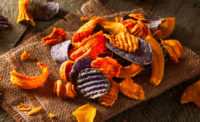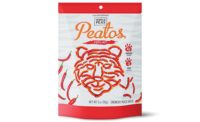Puffed and extruded snacks, including crunchy and puffed cheese snacks, keto- and Paleo-friendly pork rinds, and better-for-you veggie chips/straws and similar products have all seen good sales traction over the past few years (52 weeks ending April 17, 2022, IRI, Chicago):
- “Other salted snacks,” up 18.4% to $6.6 billion over the past year
- Cheese snacks, up 8.9% to $3.3 billion
- Corn snacks, up 13.2% to $1.9 billion
- Pork rinds, up 5.6% to $630.0 million
For a broader look at category activity, updates, and innovations see “State of the Industry 2022: Puffed and extruded snacks offer variety, healthy options.”
To gain additional R&D and processing perspectives on puffed and extruded snacks, we reached out to Julie Prost, pilot plant manager and process engineer, Clextral USA, and Sylvie Brunel, innovation and process director, Clextral SAS.
Douglas J. Peckenpaugh: What do you see as the top trends in puffed and extruded snacks today?

Julie Prost
Julie Prost: Better-for-you snacks, for sure, but with some new twists. High-protein and low-carb snacks with good fats, dual-textured snacks with interesting flavor combinations, and fun, kid-focused snacks from healthy grains and vegetables, and baby snacks designed to be first foods.

Sylvie Brunel
DJP: What are the challenges that face snack producers when developing new puffed and extruded snacks that use alternative substrates?
SB: Getting the precise amount of expansion and the desired textures can be challenging with some grains and vegetables, depending on their starch, fiber, gluten, and oil content. In some cases, product shape, and/or certain aesthetics can be more difficult to achieve with new ingredient blends.
JP: When we are processing high levels of protein and/or fat, we have to test and fine-tune the process parameters to get the right mouthfeel and degree of crispiness. When formulating for a specific diet or nutrient claim, we have to precisely control the process temperatures to avoid degradation or off-flavors.
DJP: How can innovations in extrusion equipment help build consumer interest in new puffed and extruded snacks?
JP: As extrusion companies invest in innovations in dies, kit systems, profiles, and parameters, we help reduce the R&D cost for the processor, and make it faster, more efficient, and less risky to develop a new product. An example of this is die innovation for our new pea snack shapes. Our R&D in parameter and recipe adjustments for texture modification is another example, and our clip-on kits that give processors flexibility to easily make different products using the same extrusion line.
SB: In addition, Clextral’s extruders’ proprietary Advanced Temperature Control ATC, a self-learning technology, provides absolute precision in temperature control in each barrel. This control is very important when working with recipes with high levels of fiber, starch, and protein. When developing new products, the vision and confidence comes easily with proof in the test plant, which benefits the snack manufacturers and CPG companies.





